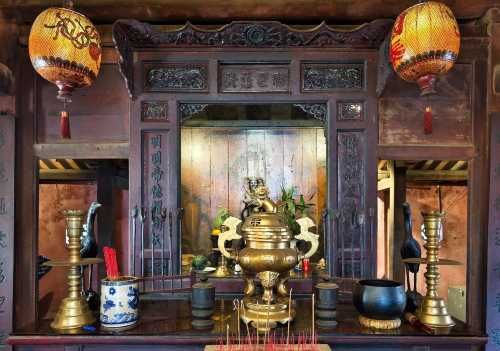Colorful Lanterns, Ancient Walls—Hoi An’s Timeless Charm 🎏🌅 Hoi An’s Old Town comes alive as dusk falls—lanterns glowing, riverboats drifting, and centuries-old streets inviting you to wander. Start your evening at Duc An House (129 Trần Phú, 8:00–21:00), savoring its vintage architecture and bookish vibe (perfect for quiet photos of wooden carvings and sunlight streaming through antique windows). Next, stroll towards Quan Cong Temple (24 Trần Phú) for bold reds and statement dragons—make sure to snap the ornately decorated altar for that “iconic Hoi An” shot. When the sky shifts to purple and gold, continue to the riverside for a magical night boat ride among floating lanterns. This is pure Hoi An magic! For a sunset memory, perch on the edge of the river—capture golden reflections and multi-colored lights flickering on the water (the ultimate insta-worthy moment!). Then dive into Hội An Night Market (Nguyễn Hoàng, 18:00–22:00) for street eats, vibrant lanterns, and the best souvenir shopping. Try crispy Banh Mi or fresh spring rolls as you explore. Don’t miss Bài Chòi Hội An (Old Town, 19:00–21:00) where live folk singing adds extra sparkle to your stroll. If curious about local spirituality, pass by Hội Thánh Tin Lành Việt Nam (114 Đ. Phan Chu Trinh) for quiet photo ops or a reflective moment. Tips: First-time visitors—going after sunset adds extra magic! Wear comfy shoes for cobblestone lanes, keep cash for market nibbles, and bring a light jacket (evenings can be breezy by the river). Watch your step boarding those lantern boats. #HoiAn #LanternNight #VietnamCulture #SunsetVibes #TravelAsia
CHONG SOON FAI
Did you know the iconic landmark on Vietnam’s 20,000 dong note is the Japanese Covered Bridge in Hoi An? 🏯✨ Built in the 17th century by Japanese merchants, it symbolizes the blend of Japanese, Chinese, and Vietnamese cultures. Visiting this bridge feels like stepping into the note itself — full of history, charm, and beauty. Don’t miss this must-see spot when exploring the lantern-lit streets of Hoi An! 🇻🇳💛 #HoiAn #Vietnam #Travel
jamesmtlim
Popular Trip Moments
Hoi An Nights✨ | World Cultural Heritage – Hoi An Ancient Town, Vietnam | 🌿taran. – A relaxing lifestyle shop in Hoi An run by a Japanese owner | 🌙 Hội An – A magical night of flickering lights | 🇻🇳[Hoi An] Sunset, a glass of the sea's gift — Afterglow at Ubebe in Hoi An | Hoi An Magic Day✨Chasing colors | 🌿 รีวิว Legacy Hoi An Resort – สวรรค์แห่งความสงบใ | 🇻🇳[Hoi An] The taste of learning found on the main street of Hoi An, NOODLE House by STREETS | Day 3 of my Da Nang trip | Hoi An a perfect cultural heritage | 🇻🇳[Hoi An] Leisure in an open space, a place for Vietnamese people to relax, KAYO COFFEE HOUSE | 🇻🇳[Hoi An] A place where refined taste and leisure linger, Thúng Hội An Restaurant | Heart of Central Vietnam: DaNang and HoiAn 🏮 | 🏮 Hoi An Old Town: A Walk Through Time | 🛶 Hoi An's emotional experience, basket boat | Highly recommend Cozy An Boutique Hotel | Hoi An Heritage Walk🚶 Discovering Japan’s Legacy in Hoi An | Sunny Hoi An Vibes☀️ | Uncle Huan, a Hoi An cafe with a great view of Ba Mu Temple | Faifo coffee, a popular cafe in Hoi An Old Town💛 | Giving away a travel plan for Da Nang and Hoi An for under ten thousand! | Vietnam's UNESCO World Heritage Site, Hoi An Ancient Town | Recommended 4-day trip to Da Nang | BEST value for money vacation in Asia | ☕️ Hoi An Cafe Tour | Hoi An Rooftop Cafe & Bistro | Hoi An bubble tea restaurant | Hoi An's Cozy Cafe Vibes
Recommended Attractions at Popular Destinations
Popular Attractions in Paris | Popular Attractions in Chefchaouene | Popular Attractions in Melbourne | Popular Attractions in Bali | Popular Attractions in Bangkok | Popular Attractions in London | Popular Attractions in Los Angeles | Popular Attractions in Shanghai | Popular Attractions in Beijing | Popular Attractions in Barcelona | Popular Attractions in Las Vegas | Popular Attractions in Osaka | Popular Attractions in Tokyo | Popular Attractions in Walt Disney World Resort | Popular Attractions in Rome | Popular Attractions in Kuala Lumpur | Popular Attractions in Dubai | Popular Attractions in Singapore | Popular Attractions in Kyoto | Popular Attractions in Iguazu National Park(Argentina) | Popular Attractions in Phuket | Popular Attractions in Zanzibar Island | Popular Attractions in Sydney | Popular Attractions in West Lake | Popular Attractions in New York | Popular Attractions in Florence | Popular Attractions in Chengdu | Popular Attractions in Madrid | Popular Attractions in Jungfrau Region | Popular Attractions in Istanbul
Popular Attractions
Emperor Qinshihuang's Mausoleum Site Museum | Huajue Lane, the Great Mosque | Shaanxi History Museum | Qinglong Temple | West Park | Puji Temple | Putuoshan Duobao Tower | Yang Guan | Mingsha Mountain And Crescent Spring | Yumen Pass | Fayu Temple | Huiji Temple | Tiananmen Square | The Palace Museum | Nanjing Andover Under Water World | Xiaomeisha Resort | Riyue Bay | Nanyan Bay | Baisha Uprising Memorial Park | Melaka Butterfly & Reptile Sanctuary (Taman Rama-rama & Reptilia Melaka) | Sector 27 Park | Stade | St. Lawrence Miner's Memorial Museum and Lunch Tin Cafe" | Park 20 | Masjid Al-Huda | Southside Park Trail Trailhead | Sai Baba Temple Balkhadi Khadaki khurd | Omemee Dam | Ban Ba Lu Ka Mosque | Venkateswara Temple
Popular Restaurants in Hoi An
Madam Khanh - The Banh Mi Queen | White Rose Restaurant | Com Linh - Vietnamese Restaurant | Miss Ly Cafe | Cong Caphe (Hoi An) | Silent Garden Restaurant | Minh Hien Vegetarian Restaurant | Faifo Coffee | The Cargo Club | Viettown- Hoi An | An Bang Beach Village Restaurant | Golden Lotus | Nu Eatery | Jack's Cat Cafe | The Temple Restaurant & Lounge | TIA Coffee & Restaurant | Restaurant HAVANA | Morning Glory Signature | Havana Bar & Restaurant | Vy’s Market Restaurant & Cooking School | Otta Cuisine | Nostalife | Trung Bac Restaurant | Lantern Town restaurant | Vinh Hung Restaurant | Vegan Zone Hoi An | Rice Drum | Cay Me | AN GIA cottage | Hoi An Burgers Plus
Popular Ranked Lists
Popular Premium Hotels Near Lipetsk | Top 50 Best Things to Do in Sydney | Top 50 Best Things to Do in Florence | Top 50 Best Things to Do in Athens | Popular Luxury Hotels Near Cartagena | Top 50 Must-Visit Restaurants in Bruges | Top 50 Must-Visit Restaurants in Chengdu | Top 50 Must-Visit Restaurants in Fukuoka | Top 50 Best Things to Do in Singapore | Top 50 Must-Visit Restaurants in Berlin | Top 50 Best Things to Do in Seoul | Top 20 Luxury Hotels near Los Altos | Top 20 Best Things to Do in Nha Trang | Top 50 Best Things to Do in Milan | Top 10 Luxury Hotels near Naperville | Top 20 Luxury Hotels near Bethesda | Top 10 Must-Visit Restaurants in Bad Ischl | Top 20 Premium Hotels near Yakushima | Top 10 Best Things to Do in Warsaw | Top 50 Luxury Hotels near Amiens | Top 10 Luxury Hotels near Rosemont | Top 50 Must-Visit Restaurants in Sydney | Top 50 Must-Visit Restaurants in Rome | Top 50 Best Things to Do in Bali | Top 10 Local Restaurants in Lushan Global Geopark | Top 50 Must-Visit Restaurants in Sapporo | Top 10 Luxury Hotels near Champaign | Top 50 Must-Visit Restaurants in Jeju | Popular Best Things to Do in Taipei | Top 50 Must-Visit Restaurants in Songyang
About
Payment methods
Our partners
Copyright © 2025 Trip.com Travel Singapore Pte. Ltd. All rights reserved
Site Operator: Trip.com Travel Singapore Pte. Ltd.
Site Operator: Trip.com Travel Singapore Pte. Ltd.










































